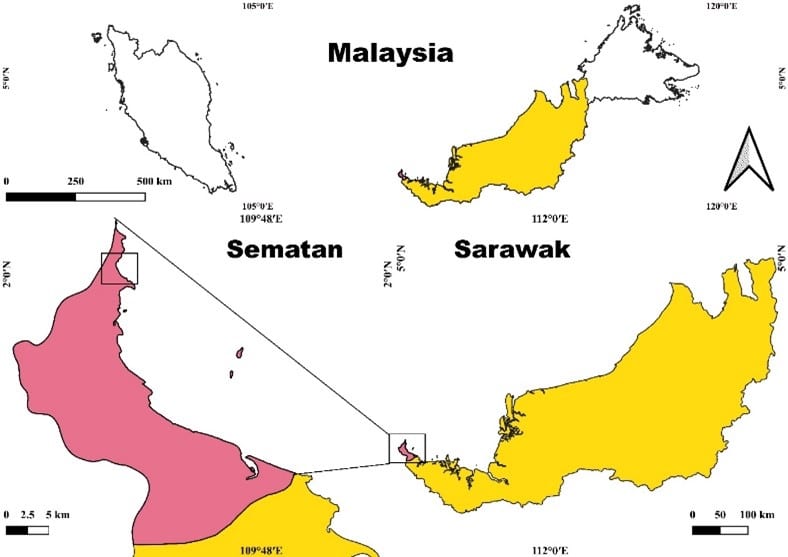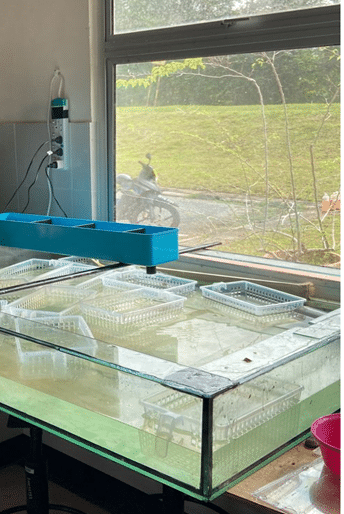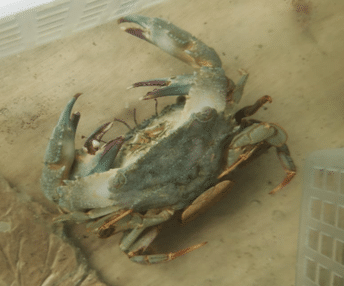Crustacean mating cycles are intricately linked to the female moulting cycle, with most sexually reproducing species engaging in mating exclusively during the "soft shell" phase, immediately post-ecdysis when the female carapace is pliable (Abdullah‐Zawawi et al., 2021; Bublitz et al., 2008; Chang and Mykles, 2011). This phenomenon, known as "softshell mating," is predominant among brachyuran crabs (Ali et al., 2020; Brink and McLay, 2010; Comeau et al., 1998). Those that exhibit soft-shell-female mating generally adhere to a rigorous courtship and guarding behavioral pattern, ensuring protection for the mated female and the inheritance of male genetic information in the offspring (Forstmeier et al., 2011; McLay and Becker, 2015). Hard shell mating, a less common adaptation, is primarily observed in semi-terrestrial species, particularly in the families Grapsidae and Ocypodidae (Hartnoll, 1975; João et al., 2021). Within portunid crabs, a rarely observed strategy, hard shell mating, has been documented in only four species all belonging to the subfamily Thalamitinae—Thalamita sima, T. picta, T. prymna, and Charybdis longicollis (Baker et al., 2018; Faria et al., 2021; Kobayashi and Vazquez-Archdale, 2018). In hard shell mating, intermoult female crabs form mating pairs with intermoult male crabs, and in species employing this strategy, both pre and post-copulatory guarding behaviors are typically absent (Herborg et al., 2006; João et al., 2021; Kobayashi and Vazquez Archdale, 2020). Thalamita crenata, commonly known as the crenate or mangrove swimming crab, is a widely distributed portunid crab in marine and brackish waters of the Indo-West Pacific Regions (Mustaquim et al., 2022). The multifaceted nature of T. crenata, the mangrove swimming crab, unfolds through an array of scientific investigations spanning diverse ecological and physiological dimensions. Research endeavors illuminate the influence of dissolved oxygen on metabolic rates and thermal sensitivity, unravelling the intricate dance between this tropical aquatic crab and its heterogeneous environments (Fusi et al., 2021). From Thailand's coastal habitats, a comprehensive case study showcases how increasing habitat complexity intricately shapes crab density, offering insights into the interplay of environmental factors on population dynamics (Tuntiprapas et al., 2021). Notably, studies delve into the critical thermal maxima of T. crenata, alongside the intertidal crab species Scylla olivacea, revealing thermal acclimation nuances vital for understanding these crustaceans' physiological adaptations (Azra et al., 2020). As we journey across Southeast Asian waters, from Setiu Wetlands in Malaysia to Lasongko Bay in Indonesia, investigations unfold the biological aspects and size at maturity of male T. crenata, shedding light on the species' life history (Amin-Safwan et al., 2019; Hamid et al., 2019). Genomic explorations extend our understanding, unravelling the complete mitochondrial genome of the spiny rock crab and tracing its phylogenetic relationships (Tan et al., 2016; Xie et al., 2018). Meanwhile, ecological surveys in various regions, from Terengganu Coastal Waters to Kung Krabaen Bay, Thailand, assess species diversity, abundance, and the impact of collapsible crab trap fisheries on marine crab populations (Kunsook and Dumrongrojwatthana, 2017; Muhd-Farouk et al., 2017). Further studies delve into T. crenata role as a bio indicator, evaluating its ability to accumulate and biodegrade butyltin compounds in Taiwan's Kaohsiung Harbor (Chen et al., 2016). From gender-specific metal bioaccumulation effects to homing mechanisms based on underwater landmark memory, and the intricate feeding behaviour of this cannibalistic scavenger, a mosaic of knowledge emerges (Cannicci et al., 1995, 1996, 2000; Chen et al., 2005; Mckillup and Mckillup, 1996). These collective efforts contribute to a holistic understanding of T. crenata, encapsulating its ecology, behaviour, and physiological adaptations in response to a myriad of environmental stimuli (Kannupandi et al., 1997; Lin et al., 2015; Tullis and Kamemoto, 1974; Vezzosi et al., 1994a; Vezzosi et al., 1994b). The mating behaviour of crustaceans, particularly in the context of brachyuran crabs, has been extensively studied, with a predominant focus on soft shell mating (Asakura, 2009; Hayden et al., 2007). However, the phenomenon of hard shell mating, characterized by mating events occurring between intermoult female and male crabs, is a scarcely documented adaptation within portunid crabs (Orensanz et al., 1995; Sayekti et al., 2020; Watanabe et al., 2008). This study addresses the significant gap in our understanding by presenting the first report of hard shell female mating in T. crenata, a widely distributed portunid crab. The rarity of hard shell mating in portunids, coupled with the absence of pre and post-copulatory guarding behaviour in species employing this strategy, raises intriguing questions about the reproductive dynamics and adaptations in T. crenata. Moreover, the feasibility and challenges of breeding this species in captivity remain largely unexplored. This investigation aims to contribute to the broader knowledge of crustacean mating strategies, specifically shedding light on the unique reproductive behaviour observed in the crenate swimming crab, and further exploring the potential for breeding T. crenata in captivity, which could have implications for conservation and aquaculture practices.
2. Materials and Methods
2.1 Ethical approval
No ethical approval is required for this study.
2.2 Study area and period
The mature individuals of T. crenata encompassing both sexes (male and female) were procured through the utilization of baited box traps deployed in Telok Melano, Sematan, Sarawak (2.0070° N, 109.6461° E) during the period from 1st June to 21st June 2022 (Figure 1).
 Figure 1. The area from where the crabs were captured Telok Melano, Sematan, Sarawak, Malaysia.
Figure 1. The area from where the crabs were captured Telok Melano, Sematan, Sarawak, Malaysia.2.3 Laboratory observation
Subsequent to capture, the specimens were transported to the Aquatic Research and Teaching Laboratory at Universiti Putra Malaysia Bintulu, Sarawak (UPMKB), Malaysia. Under laboratory settings, the crabs were collectively housed in a glass aquarium measuring 2 m in width, 1 m in length, and 0.2 m in height, filled with filtered seawater (25 PSU). The aquarium was equipped with essential amenities including an overhead filter, protein skimmer, aerator, and ultraviolet sterilizer (Figure 2). The water conditions were maintained at ambient temperatures. A cohort of 22 inter-moult crabs, comprising 10 females and 12 males, with carapace widths ranging from 53 to 89 mm, were introduced into the tank on 23rd June 2022. Rectangular plastic baskets were provided as shelters within the tank. The rearing facility, situated indoors, allowed for natural light penetration through lightly tinted glass windows. The crabs were subjected to a daily feeding regimen consisting of squid and marine fish. Tank maintenance involved the siphoning of uneaten food and waste every two days, with water replenishment conducted accordingly. The absence of substrate facilitated unhindered observations and simplified cleaning procedures. Throughout the experimental trial, the crabs were afforded unrestricted mobility within the confines of their enclosure. Daily observations were conducted to detect any instances of pre or post-copulatory guarding behaviours.
 Figure 2. Experimental tank for observing the mating crabs.
Figure 2. Experimental tank for observing the mating crabs.
3. Results and Discussion
After a 50-day period following the initial stocking on August 13, 2022, a noteworthy occurrence of mating was observed within the T. crenata population. Remarkably, a mating pair consisting of both male and female crabs in the intermoult stage engaged in copulation, an event meticulously documented through the use of digital video and photographic records. The observed mating behaviour exhibited distinctive characteristics, with the male employing a forceful grip to grasp the female and utilizing one cheliped to position her beneath him, facilitating copulation (Figure 3). Subsequent to this intricate manoeuvre, the male promptly extended his abdomen, effecting copulation by inserting it inside the female’s abdomen. The entire copulatory process transpired within a relatively brief timeframe, lasting approximately 8 minutes. Following copulation, the male disengaged his abdominal flap from the female and released her. The significance of this observation lies in its representation of the first report documenting T. crenata engaging in hard shell female mating. This particular mating strategy, characterized by its rarity, has previously been documented in various crab species within the subfamily Thalamitinae (Asakura, 2009; João et al., 2021). The violent gripping and positioning observed in T. crenata aligns with the broader patterns observed in hard shell mating behaviours within the subfamily, further contributing to our understanding of the diverse reproductive strategies exhibited by crustaceans in the family Portunidae. The brevity of the copulation period, lasting approximately 8 minutes, is noteworthy and warrants consideration in the context of the species' reproductive biology and evolutionary adaptations.

 Figure 3. Mating hard shell pair of Thalamita crenata.
Figure 3. Mating hard shell pair of Thalamita crenata.
4. Conclusions
In conclusion, this discovery enriches our understanding of T. crenata's reproductive ecology, opening avenues for further investigations into the underlying mechanisms and implications of hard shell mating in this species and others within the genus Thalamita.
Acknowledgements
The first author gratefully acknowledges the logistical support provided by Universiti Putra Malaysia Bintulu, Sarawak (UPMKB), Malaysia.
Data availability statement
All data are presented inside the manuscript.
Informed consent statement
Not applicable.
Conflict of interest
The authors declare no conflict of interest.
Author contributions
Lirong Yu Abit: conceptualization, technique, research, formal analysis, original draft writing, review, and editing; Julia Moh: reviews, editing, and formal analysis; Jongkar Grinang: formal analysis, writing, review, and editing; Wan Zabidi Wan Morni: writing, editing, and reviewing; Abdulla-Al-Asif: writing, editing, and reviewing; Kamil Latif: conceptualization, writing, editing, and reviewing. All authors critically reviewed the manuscript and agreed to submit final version of the article.



